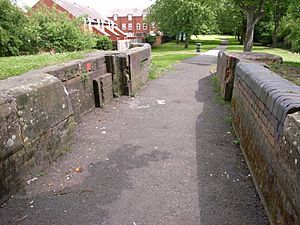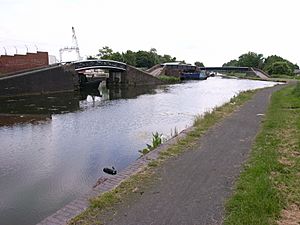Tipton Green and Toll End Canals facts for kids
The Tipton Green Branch and Toll End Branch were two narrow canals that were part of the Birmingham Canal Navigations system. These canals were located near Tipton in the West Midlands, England. Today, these canals no longer exist.
Contents
History of the Canals
The Tipton Green Branch was finished around 1805. It was about a quarter of a mile long and had three locks. Locks are like water elevators that help boats move up or down between different water levels.
Building the Toll End Branch
The Toll End Branch was approved by a special law from Parliament in 1783. This law also approved other canals, like the Birmingham and Fazeley Canal. The idea was to build the Toll End Branch to reach a new coal mine.
Work on the Toll End Branch started from the Broadwaters Canal, which is now part of the Walsall Canal. However, construction stopped in 1784 for eight years. It was finally completed in 1801, with two locks.
In 1806, people decided to make this branch longer and connect it to the Tipton Green Branch. More locks were added. By January 1809, the Toll End Communication Canal was finished. This made the total length of the Toll End Branch about 1.375 miles.
Changes and Connections
In 1829, a new main canal line, called the BCN New Main Line (also known as the Island Line), was built by Thomas Telford. This new line cut across the Tipton Green Canal. This created a new spot called Watery Lane Junction.
After this, the Tipton Green Canal effectively became two parts:
- The Tipton Green Locks Branch, which had three locks.
- The Toll End Locks Branch, which had seven locks.
From the late 1900s, a place called Caggy's Boatyard was located at the Watery Lane Junction.
Horseley Ironworks
The Horseley Ironworks had its first factory between these two canal branches. This was a very important place! Many famous iron bridges were made here. These include the Engine Arm Aqueduct (built in 1825), two roving bridges at Smethwick Junction (built in 1828), and the Galton Bridge.
Why the Canals Closed
For over a hundred years, fewer and fewer boats used these canals. This happened because trains became popular, and then motor vehicles took over.
The Tipton Green Branch stopped being used in 1960. The Toll End Branch closed in 1966. Some of the locks on the canal became stuck and could not be moved. In 1968, the canals and their locks were filled in with earth.
Houses were built along the Tipton Green locks in the mid-1800s. However, these houses were torn down around the time the canal closed.
What Remains Today
Even though the canals are gone, you can still see some parts of them. The brick base of one lock on the Tipton Green Canal is still there. It is now part of a public walking path that opened around 1975. This path follows where the canal used to be.
One part of the Toll End canal is now a car park for a factory. There is also an "open" drain that follows the old canal route behind Tipton Cemetery. But other than these small parts, the canal has mostly disappeared.
Most of the old bridges that crossed the canals are still standing. However, the bridge on Bridge Road, which carried the road under the Toll End Canal, was replaced with a flat road after the canal was filled in.




